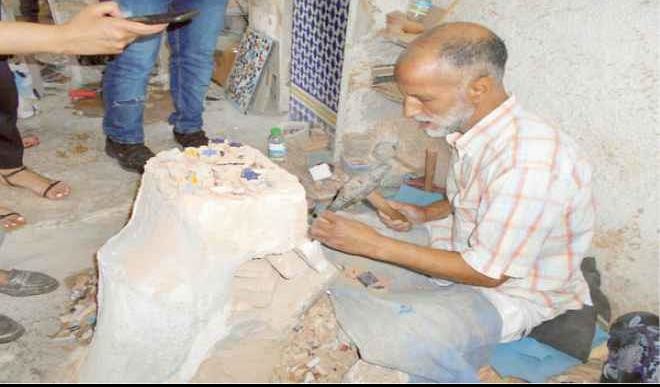
“Smile, you are in Fez!” That was all a weather-beaten banner, plastered on a weary but magnificent wall screamed. It was a message directed at the thousands of tourists who usually besiege the Fez, the Moroccan city historical that has its medina (old city) already listed as the United Nations Educational Scientific and Cultural Organisation (UNESCO) World Heritage site.
Described as Morocca’s spiritual centre, Fez is also known as “the melting point of succeeding cultures” and one that is as widely regarded as the great open air-museum.
Fez no doubt has in abundance, what can actually make a visiting tourist smile. It is home to Moroccos’s Ibn Danan Synagogue, reputed to be the oldest Jewish synagogue in the whole of North Africa and the imperial Mejdoubi – the royal palace gate said to have been constructed between 13th and 14th century.
There is also the Fabrication De Porterie – the potteries centre of different shapes, sizes, and designs, the Chouwara Tannery, considered to be the oldest in Africa and second in the world after that of India and Bou Inania Madrasa- an Islamic centre and a mosque constructed in the 14th century, among others.
The tourists aren’t the only ones smiling in Fez. The locals are too.
For many of its residents, the tourism endowments of Fez are sources of livelihood that have become inseparable from their existence. Thus, whether one finds him or herself within the urban or metropolitan part of the city, the locals, many of whom are small and medium scale operators are common sights.
While many are largely traders providing all sorts of souvenirs and memorabilia within the city’s sprawling market, there are drivers who live on their cabs’ conveyance of tourists. There are also restaurants and bar operators who live largely on providing meals ranging from local to intercontinental dishes as well as drinks.
In the list of benefitting locals are artisans whose special talents, crafts and trades also attract tourist visitations. For instance, at the Art d’angiLe Pottery Store, Muhammed Ejjane, regarded as a long time mosaic designer said, although the younger generation have not been showing much interest in the craft and trade, he has nonetheless been earning a descent living from it.
Another pottery carver who simply identified himself as Azeez said, “Pottery carving and trading has been of immense benefit to me and my family. This is one trade that gives me happiness because for every good work I put out there, I’m more than convinced that a tourist with a good price will pick it up.”
Husseiyat Oulhouk, an older woman potter and Hikram Kubayt, a lady potter also aligned with Azeez. For them, pottering carving is not just a means of earning their living but one that has also become their passion.
Those whose passion mix with businesses could also be found at the ‘tie and dye’ clothing section, the Seffarine square, where the bonze casters also ply their trades and Chouwara Tannery where the processing of mainly sheep and goat hides have thrived for centuries.
The tannery oozes a very terrible smell – one that often causes visitors great discomfort. Yet, for hundreds of artisans working hard to produce dyed hides being used for iconic leather bags, shoes, belts and other human accessories, no terrible odour is too suffocating to bear.
Instructively, being a tourist guide is another profitable venture among Moroccans of different ages in Fez. With many attractive sites to visit, guides have ready-made “buyers” of their historical knowledge, skills and narratives. But while some are recognized and registered, there are also the unregistered and unsolicited guides who often strategically position themselves at each of the notable sites of visit. They simply close in on tourists to offer explanations or give historical accounts with the hope of being financially rewarded at the end.
“I’m aware that we have about 400 registered tourist guides,” Hesham Ali, of Azami Voyage said. Ali was the tourist guide for the 12 international journalists participating in the 2017 Senior Journalists Seminar of the East West Center and who were in Morocco for the third leg of their study and tour programme.
According to Ali, the services industry, driven principally by tourism, currently contributes 52 percent to Morocco’s economy.
“The tourism sector is very promising here. Our King also has a vision of expanding the industry beyond what it is currently. As we speak, Morocco has about 12 million tourists visiting it from different parts of the world on annual basis. The king’s vision is to expand that population to 20 million by 2025. That would be no mean a feat,” Ali said.
Central to the set objective of Muhammed VI on expanding tourism in Morocco is the continuous preservation of the city of Fez and its monuments, Ali said.
Reputed as the first capital of Morocco, Fez is also one of the four known imperial cities of the kingdom (the others being Rabat, Mekness and Marrakech). Its town was said to have been established by its first ruler, Idris I in 789, while his son and successor Idris II, who took over in 809 was credited with the city’s development as a worthy capital with the building of the royal palace, mosque, Kissaria (covered market), canals and walls.
Ali said Fez’s current population is about three million. A significant percentage of that figure, he added, has their livelihood tied to the city’s tourism endowments.





